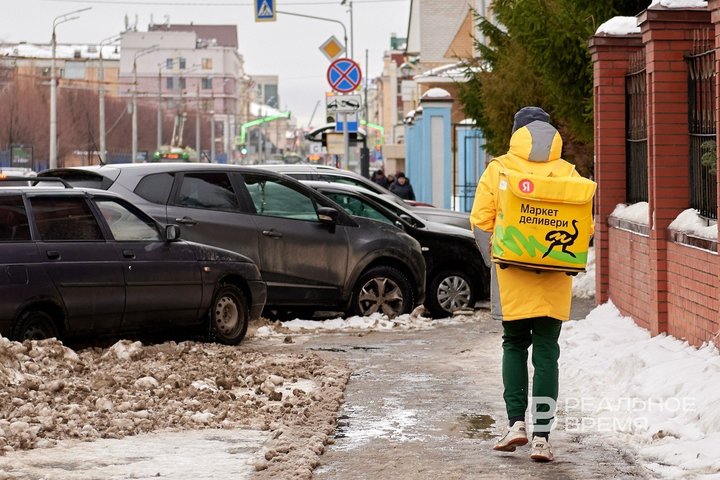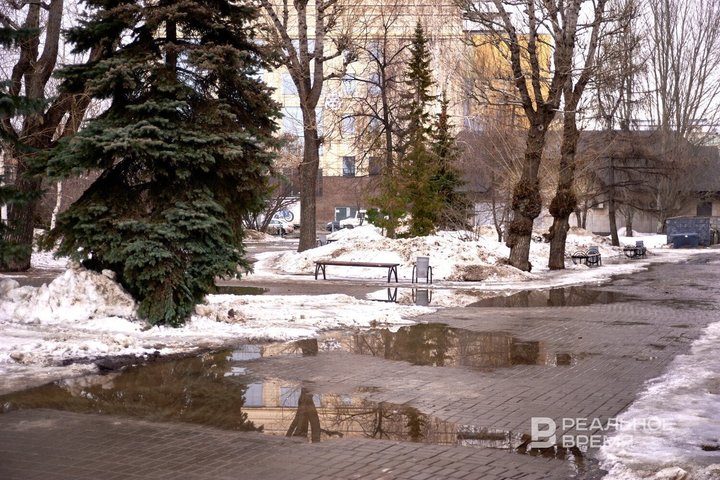Rotting recorded on fields of Tatarstan — will winter crops die?
Temperatures in the Republic of Tatarstan are going to pass through the zero mark by March 8

Rotting has been recorded in at least two locations in Tatarstan, a dangerous agrometeorological phenomenon fraught with damage and death of winter crops. Felix Gogol, the head of the Hydrometeorological Centre of the republic, told Realnoe Vremya about this. Tatarstan residents remember the winter with abnormally high temperatures, which will also exceed the norm in early spring. About what kind of weather the celestial chancellery has prepared for March 8 and when to expect snowmelt — read the material of Realnoe Vremya.
Average daily temperatures will be by 4-5 degrees above normal
In Moscow, the thermometer will break the +10 degree mark at the beginning of next week, says Evgeny Tishkovets, a leading specialist at the Fobos weather centre, in his telegram channel. It is too early for Tatarstan residents to expect such warming, said Felix Gogol, the head of the republic's Hydrometeorological Centre. Nevertheless, the temperature in the region will exceed the long-term norm.
“In the coming days, the temperature background in Tatarstan will really increase both at night and in the daytime. From March 6 to March 8, the maximum daytime temperatures in the republic will be around +1...+2 degrees, at times slightly freezing. Temperatures below zero are still expected everywhere at night," he said.
According to the expert, -3.8 degrees and -1.6 degrees are expected at night on March 7 and 8, respectively. Daytime temperatures are expected to range from +2 to -3 degrees and +1 to -3 degrees.

“On March 9 and 10, the temperature background will increase even more, and the average daily temperatures will be somewhere 4-5 degrees above the climatic norm for a given day," Felix Gogol assured.
From morning to evening, “completely positive temperatures” are expected, about +2..+4 degrees. Nighttime levels will also gradually increase. The reason is that the Scandinavian cyclone will bring warm air masses to the Volga region. “But we do not expect such values as in Moscow over the next five days," stressed the head of the Hydrometeorological Centre of the republic.
As for precipitation, moderate amounts are expected in the coming days. It will snow, sleet and even rain in the regions of the republic.

“Now it is difficult to objectively give a picture of what will happen in April — May”
Last winter has been one of the warmest in Russia — it took the second place, said Roman Vilfand, the scientific director of the Hydrometeorological Centre of the country, recently at a press conference. In Tatarstan, according to Felix Gogol, large temperature anomalies have been observed in the past. “There were years when December, January, February were a bit warmer [than this year]. This winter can be called abnormally warm, but not record-breaking," the expert explained.
The peculiarities of the season have repeatedly caused concern among farmers.
“Major risk we face is [a shortage of] moisture reserves. The final figures of the 2025 harvest will depend on how it is implemented. There aren't enough moisture reserves in soil right now, but it's not critical for winter. The main thing is how they will be distributed in the spring. On the one hand, the snow cover, which has now covered most of the crops, will replenish moisture reserves during melting. But 11 cm of cover (this is the average in Russia — ed.) is not enough to completely fill the deficit. The situation will continue to develop depending on the rains in the spring," Arkady Zlochevsky, president of the Russian Grain Union, said earlier.

In Tatarstan, the amount of snow and the depth of soil freezing vary depending on the region. For example, there is more snow in the eastern part than in the western, Felix Gogol gave an example.
“All crops that are grown in our republic, regardless of whether they are winter or spring, depend primarily on precipitation in the spring period. <...> And it is almost impossible to predict how many there will be now. Mostly short-term forecasts are justified well. Unfortunately, long-term forecasts have a worse justification, so now it is difficult to objectively give a picture of what will happen in April and May," he complained.
When can Tatarstan citizens expect snowmelt? According to Professor Yury Perevedentsev, the normal meteorological spring in our region occurs from March 30 to April 1 — during this period, the average daily temperature goes over zero in the upward direction. The snow cover steadily melts around April 10. But nowadays, with global warming, spring can start earlier, he added.

Rotting has been was recorded in at least two locations in Tatarstan
However, there is a problem in agriculture that is well known. At least two locations in Tatarstan have recorded rotting, a dangerous agrometeorological phenomenon that can lead to damage and death of winter crops. Such data was shown by AMS Aznakaevo and AMP Aksubaevo.
As explained on the website of the Hydrometeorological Centre of Tatarstan, prolonged occurrence of high snow cover with slightly frozen or thawed soil leads to rotting. The minimum soil temperatures at the depth of the tillering node were kept within 0..-1 degree. This caused an increased consumption of nutrients for increased respiration and a decrease in winter hardiness of plants.
The relevant research is not conducted in all fields of the republic. “In some areas where there is no surveillance, this phenomenon could also be realised. Or it might not have been realised. We have no supporting data about this," Felix Gogol explained.
According to Professor Yury Perevedentsev, winter crops may be adversely affected by the lack of snow and atypical precipitation, which was observed at the height of the calendar winter.
